From the Editor
I was diagnosed with pityriasis rubra pilaris (PRP) on November 28, 2012 – nearly three months after a red spot appeared on my forehead.
 Someone from my dermatologist’s office called me to confirm the diagnosis and to schedule an appointment for the following day. All she shared with me was the proper spelling of pityriasis rubra pilaris.
Someone from my dermatologist’s office called me to confirm the diagnosis and to schedule an appointment for the following day. All she shared with me was the proper spelling of pityriasis rubra pilaris.
That evening I performed a series of internet searches and devoured two dozen healthcare-related websites. Unfortunately, the information I uncovered was limited in scope and redundant in content. Even more disconcerting, however, was the presumption that I was familiar with medical terms. Arrgh!
Sometime during the early morning hours of November 29, as I became overwhelmed by my ignorance, I knew I needed to find a PRP Survival Guide.
When I discovered that there wasn’t one, I started writing it. Three years ago – May 20, 2015 – the PRP Survival Guide was officially introduced to the worldwide PRP community.
SEARCHING THE INTERNET
 The PRP Survival Guide is offered as an alternative to unstructured and random forays using Dr. Google and Dr. Yahoo. All too often these efforts lead to redundancy, frustration and even misinformation. If we do are job properly, you will either (1) find the answers you seek or (2) find other options. Learn more about using Dr. Google.
The PRP Survival Guide is offered as an alternative to unstructured and random forays using Dr. Google and Dr. Yahoo. All too often these efforts lead to redundancy, frustration and even misinformation. If we do are job properly, you will either (1) find the answers you seek or (2) find other options. Learn more about using Dr. Google.
SEARCHING THE PRP SURVIVAL GUIDE
 Please use the SEARCH field to locate posts, PDFs and other links. questions, chapters and topics. The most effective way to access a specific Chapter Index is to use the Table of Contents link below.
Please use the SEARCH field to locate posts, PDFs and other links. questions, chapters and topics. The most effective way to access a specific Chapter Index is to use the Table of Contents link below.
 TRANSLATE FEATURE
TRANSLATE FEATURE
Every page in the PRP Survival Guide has a TRANSLATE button powered by Google Translate. The pull-down menu offers 100 language options. The translation applies to the post/page as well as any replies that follow.
The PRP Survival Guide is divided into four sections:
THE BASICS
We begin PRP 101 with the basics. Whether you are a newly diagnosed patient or supportive caregiver (spouse, partner, parent, family or friend), or a more “seasoned traveler”, the questions we hear most often fall conveniently into two categories:
❏½ Questions with answers you WANT to know
❏½ Questions with answers you NEED to know
TREATING PRP
Treating PRP focuses on treatment options (prescription drugs and topicals) as well as managing our expectations. We all learn early in our PRP journeys that the efficacy of treatment is a roll of the dice. We also learn that not all dermatologists are created equal. Not all dermatologists are PRP savvy. We want patients and caregivers to have a basic understanding of the options and confident in your ability to ask your dermatologist important questions.
DAILY LIFE
Every aspect of the PRP experience … coping with the 24/7 challenges to body, mind and spirit. Feedback by hundreds of fellow travelers who have shared their insights based on their unique journeys with posts and comments from members of the PRP Facebook Support Group.
THE ENDGAME
For most PRP patients and caregivers, the outcome we seek is remission. The definition of remission can include “symptom-free with meds”, “remission with remnants”, and the least technical variation: “I finally have my life back”. For others, the PRP journey is defined by long-term management of symptoms rather than remission.
DISCLAIMER
The PRP Survival Guide is designed for educational purposes only and not for the purpose of rendering medical advice. It is not the intention of the PRP Survival Guide to provide specific medical advice, but rather to provide users with information to better understand and manage the burden of pityriasis rubra pilaris on body, mind and spirit. No individual should indulge in self-diagnosis or embark upon any course of medical treatment that is described in the PRP Survival Guide without first consulting a health care professional.



